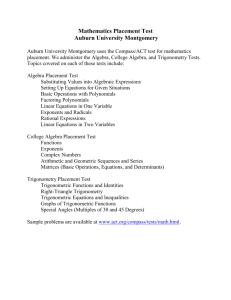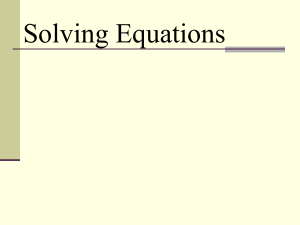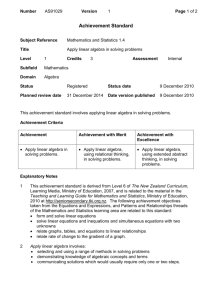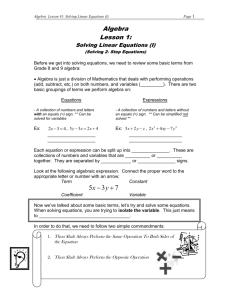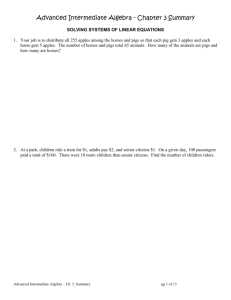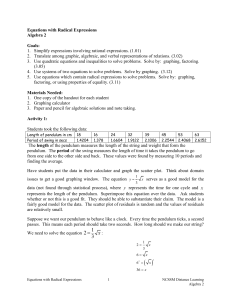Algebra Equation Solving Flow Chart
advertisement
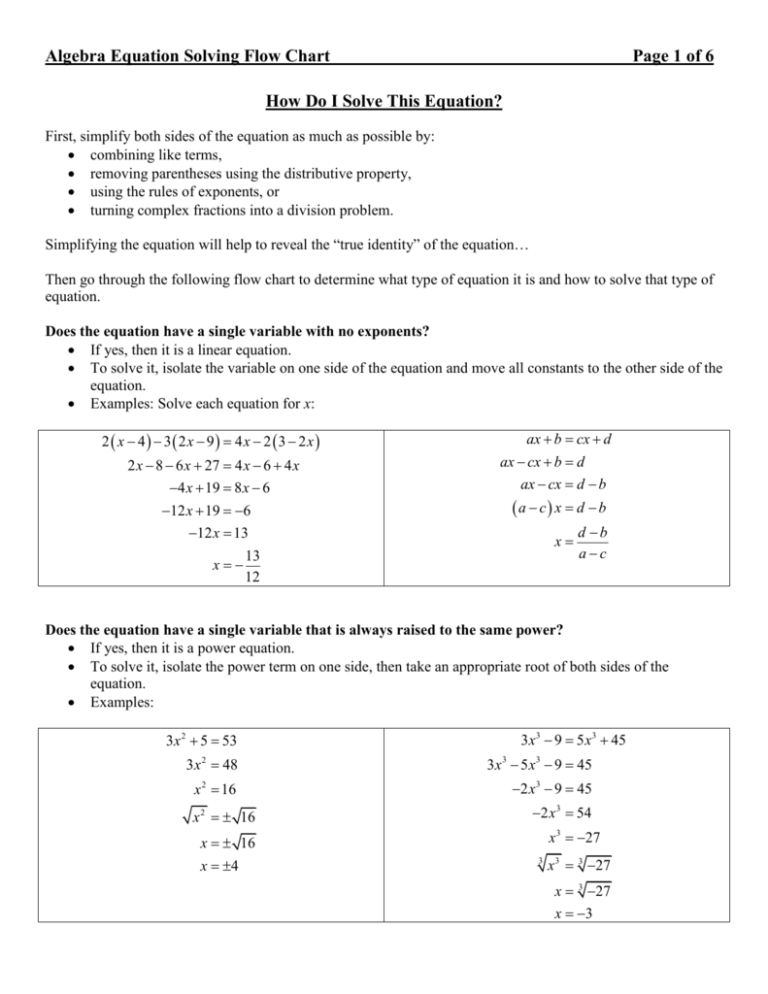
Algebra Equation Solving Flow Chart Page 1 of 6 How Do I Solve This Equation? First, simplify both sides of the equation as much as possible by: combining like terms, removing parentheses using the distributive property, using the rules of exponents, or turning complex fractions into a division problem. Simplifying the equation will help to reveal the “true identity” of the equation… Then go through the following flow chart to determine what type of equation it is and how to solve that type of equation. Does the equation have a single variable with no exponents? If yes, then it is a linear equation. To solve it, isolate the variable on one side of the equation and move all constants to the other side of the equation. Examples: Solve each equation for x: 2 x 4 3 2 x 9 4 x 2 3 2 x 2 x 8 6 x 27 4 x 6 4 x 4 x 19 8 x 6 12 x 19 6 12 x 13 x ax b cx d ax cx b d ax cx d b a c x d b x 13 12 d b ac Does the equation have a single variable that is always raised to the same power? If yes, then it is a power equation. To solve it, isolate the power term on one side, then take an appropriate root of both sides of the equation. Examples: 3 x 2 5 53 3 x 3 9 5 x 3 45 3 x 2 48 3 x 3 5 x 3 9 45 x 2 16 2 x 3 9 45 x 2 16 x 16 x 4 2 x 3 54 x 3 27 3 x 3 3 27 x 3 27 x 3 Algebra Equation Solving Flow Chart Page 2 of 6 Does the equation have a single variable that occurs several times raised to different powers? If yes, then it is a polynomial equation. To solve it, make one side of the equation equal to zero, factor the other side, then set each factor equal to zero and solve the resulting “mini equations.” Examples: x 2 2 x 7 3 x 4 x x 2 2 x 3 5x 6 x2 0 x2 5x 6 2 x 3 7 x 2 3 x 4 x 3 8 x 2 12 x What two numbers have a product of 6 and a sum of -5? Answer: -2 and -3. 6 x 3 x 2 3 x 12 x 6 x 3 x 2 15 x 0 x 5x 6 0 2 x 6 x 2 x 15 0 x 2 x 3 0 x 2 0 or x2 6 x 3 7 x 2 3 x 8 x 2 12 x or x 3 0 x3 (6)(-15) = -90; What two numbers have a product of -90 and a sum of +1? Answer: +10 and -9. x 6 x 2 x 15 0 x 6 x 2 10 x 9 x 15 0 x 2 x 3x 5 3 3x 5 0 x 2 x 3 3x 5 0 x 0 or 2 x 3 0 or 3x 5 0 3 5 x 0 or x or x 2 3 Algebra Equation Solving Flow Chart Page 3 of 6 Does the equation have a single variable that occurs in the denominator of a fraction? If yes, then the equation is a rational expression equation. To solve it, multiply both sides by the LCD of all the fractions, then solve the remaining equation. Examples: 1 1 1 2 x 2 x 4x 4 x 2 1 1 1 x 2 x 2 x 2 x 2 LCD = (x + 2)(x + 2)(x – 2) 1 1 x 2 x 2 x 2 x 2 x 2 x 2 1 x 2 x 2 x 2 x2 1 x 2 x 2 x 2 x2 1 x 2 x 2 x 2 x 2 x 2 x 2 x 2 x 2 x 2 x 2 x 2 x 2 x2 4 x 2 x2 4x 4 x2 2 x x2 4x 4 2 x 4 x 4 2 5 x 4 6 5 x 6 x 5 3 3.6 y y 1 y 1 4 12 9 First, simplify the complex fraction on the left hand side: 3 9y 3 9y 3 9 y y y y y 1 3y 1 3y 1 4 12 12 12 12 9 y 3 3 y 1 3 3 y 1 12 36 y 12 y 3y 1 y Now, solve the equation: 36 3.6 y y 1 36 3.6 y y 1 y y 1 y y 1 36 y 1 3.6 y 36 y 36 3.6 y 32.4 y 36 36 360 10 y 32.4 324 9 Algebra Equation Solving Flow Chart Page 4 of 6 Does the equation involve radicals? If yes, then it is a radical equation. To solve it, isolate the radical on one side of the equation, then raise both sides of the equation to an appropriate power to “undo” the radical. If the equation has more than one radical, isolate one of the radicals, raise both sides to an appropriate power, then isolate the remaining radical and raise both sides to an appropriate power again. Examples: x 9 x 16 7 2x 8 4 x x 9 7 x 16 2x 8 x 4 2x 8 2 x 4 2 2 x 8 x 2 8 x 16 0 x 6x 8 x 16 x20 x 2 56 14 x 16 4 x 16 x 16 16 x 16 8 8 4 4 x0 0 4 4 Check: 2(2) 8 4 2 Check: 0 9 0 16 7 9 16 7 3 4 7 4 8 4 2 4 4 2 2 9 65 14 x 16 42 Check: 2(4) 8 4 4 2 4 2 2 x 9 x 65 14 x 16 0 x 4 x 2 4 4 7 x 9 49 14 x 16 x 16 2 x 4 0 or x 4 or x9 2 Algebra Equation Solving Flow Chart Page 5 of 6 Are there two variables but only one equation? If yes, you can’t solve the equation for a single answer, but you can graph all the pairs of numbers that satisfy the equation. To make a graph you can do one of two things: o Make a table with random numbers for x, and calculated values of y. o If the equation is linear, then graph the line by putting the equation is slope-intercept form or calculating the intercepts and connecting them with a line. Examples: x 2 y 16 2x 3y 9 This has two variables; we can only graph all pairs of numbers that satisfy the equation. So, solve for y to make it easier to calculate values of y for random values of x. This equation has two variables, so all we can do is graph it. y 16 x 2 Notice: this is a quadratic equation; you should expect its graph to be a parabola. x -5 -4 -3 -2 -1 0 1 2 3 4 5 y -9 0 7 12 15 16 15 12 7 0 -9 Notice that it is a linear equation, so its graph will be a line. Here is the equation in slope-intercept form: 2x 3y 9 3 y 2 x 9 2 y x3 3 To use slope intercept form, put a point at 3 on the y-axis, then either go down 2 units and to the right 3 units, or up 2 units and to the left 3 units. You can also graph the line by finding its intercepts: x-intercept y-intercept 2x 3y 9 2x 3y 9 2 0 3y 9 2x 3 0 9 3y 9 2x 9 y3 x 4.5 plot the point (4.5, 0) plot the point (0, 3) y (-3, 5) x y (0, 3) (3, 1) x (4.5, 0) Algebra Equation Solving Flow Chart Page 6 of 6 Are there two variables and two equations? If yes, then this is a system of equations. Graph both equations; the solution to the system is the intersection point of the graphs. To calculate the intersection point use either: o Substitution: solve one equation for a variable, substituting the expression you obtain into the second equation, then solving that resulting equation for a value, or o Elimination: add multiples of the equations together so that one of the variables is eliminated. Example: 2 x 3 y 9 Solve . 3 x 2 y 8 First, graph the equations. Here are the equations in slope-intercept form for graphing purposes: y 2 y 3 x 3 y 3 x4 2 x Substitution method of solution: 2 3 x3 x4 3 2 2 3 x 3 6 x 4 6 3 2 4 x 18 9 x 24 13 x 18 24 13 x 42 42 x 3.23 13 2 y x3 3 2 42 y 3 3 13 84 117 33 11 y 0.85 39 39 39 13 42 11 the intersection point is , 13 13 Elimination method of solution: 2 x 3 y 9 3 x 2 y 8 Multiply the first equation by 2 and the second equation by 3: 4 x 6 y 18 9 x 6 y 24 13 x 0 y 42 42 13 Now multiply the first equation by 3 and the second equation by -2: 6 x 9 y 27 6 x 4 y 16 x 0 x 13 y 11 y 11 13 42 11 the intersection point is , 13 13




